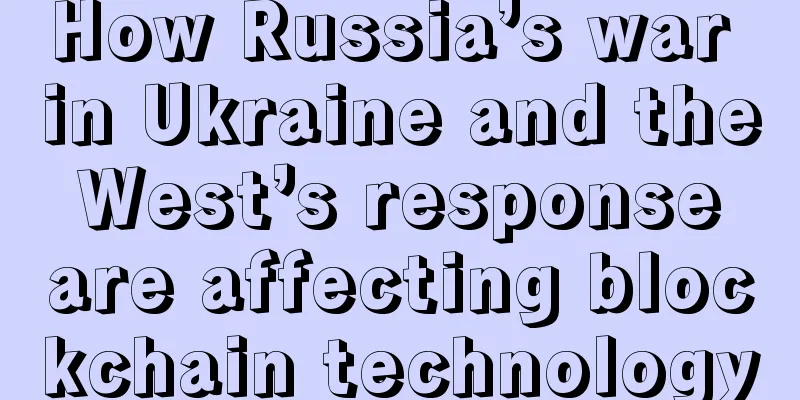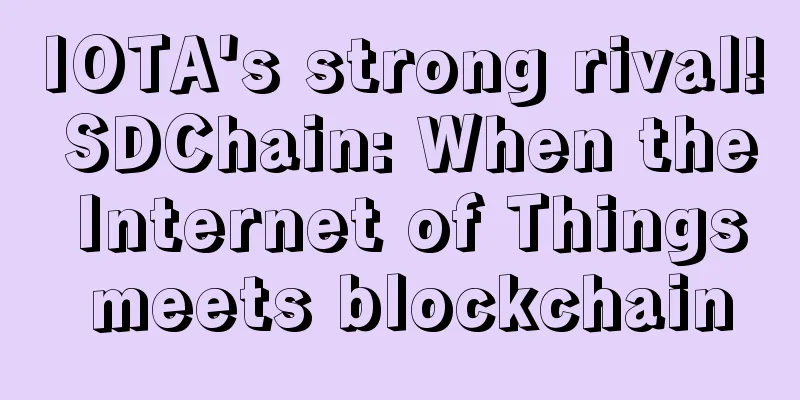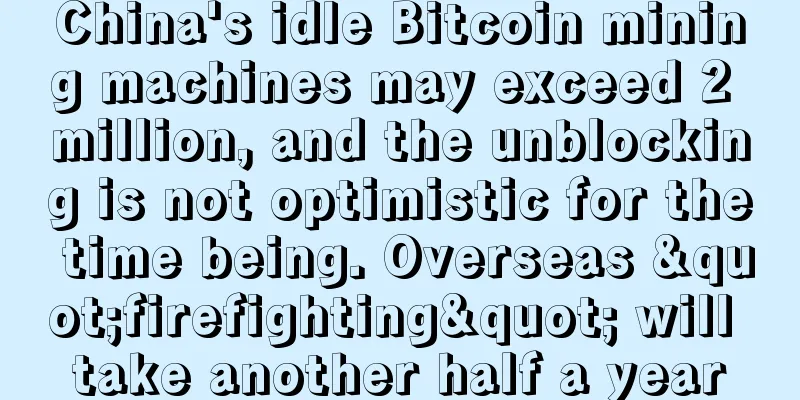How Russia’s war in Ukraine and the West’s response are affecting blockchain technology

|
When Russia launched an unprovoked invasion of its neighbor and trading partner, Ukraine, the world reacted with fear and anger. Western countries, led by the United States and the European Union, immediately imposed severe sanctions on Russian President Vladimir Putin's regime, including a ban on its access to foreign exchange reserves. The global economy has been affected by the surge in energy and commodity prices, and capital markets are dealing with the uncertainty and long-term impact of Putin's aggression and the worst military tragedy on the European continent since World War II. The cryptocurrency community has also been affected by this situation. Due to the peer-to-peer nature of blockchain technology, there are many problems with the utility of Bitcoin and other digital assets in war zones and in Russia itself. Since European and American countries have excluded some Russian banks from financial infrastructure such as the Swift system, this has greatly curbed the purchasing power of ordinary citizens. In this report, we analyze the role of macroeconomic forces and examine how blockchain-based solutions may play an important role as the war continues. Blockchain and web3 are demonstrating their value in unprecedented ways by contributing to humanitarian efforts, providing aid to Ukrainian refugees, and supporting Ukrainian citizens in defending their country against Russian forces. Before we get into the details of these moves, let’s first understand how Russia and Ukraine are affecting the macroeconomic situation. Dramatic changes in the global marketRussia is one of the world's largest economies and a major producer of energy and commodities, while Ukraine is the world leader in wheat production. Russia is the world's third largest oil producer, with about 5% of the world's oil reserves. Half of its exported oil is consumed by European countries, accounting for a third of Europe's oil consumption. Russia is also the world's largest natural gas producer, controlling 25% of global gas reserves. Crude oil prices are also surging as economic sanctions take effect. The same is true for gasoline, natural gas, coal, and heating oil. A sharp increase in electricity prices will affect proof-of-work blockchains like Bitcoin that require high energy input. Russia also has a firm grip on the fertilizer industry thanks to its high nitrogen production, and is a major exporter of copper, nickel, palladium and platinum, elements needed to produce chips and graphics cards used for cryptocurrency mining or high-end gaming. Meanwhile, Ukraine is the sixth-largest producer of titanium, a metal used primarily in manufacturing, and the third-largest producer of neon. Financial constraintsGlobal leaders have also sanctioned Russian banks, while payment service providers have ceased operations in the country. It is estimated that the Russian central bank held about $650 billion in foreign exchange reserves by mid-2021; however, these restrictions will limit this amount to around $230 billion, as 65% of the reserves are held overseas in currencies such as the U.S. dollar, euro, pound sterling and gold. The sanctions also mean that at least seven of Russia's most important financial institutions will no longer be part of SWIFT, a global messaging system crucial for cross-border payments. Swift is used by more than 11,000 institutions and generates more than 35 million transactions a day. Similarly, payment giants Visa, Mastercard, American Express, and PayPal have all ceased operations in sanctioned countries, leaving millions of users without a vital currency gateway. While Russian citizens and businesses may eventually find alternatives to Swift, financial constraints will severely harm its economy. Decentralized currency systemOne of the advantages of blockchain is the ability to enable seamless peer-to-peer transactions without intermediaries, creating virtually borderless assets. This decentralized financial ecosystem could prove helpful to the millions of Ukrainians and Russians who are deprived of direct payment gateways. However, the situation in Russia is more severe and complex. In addition to PayPal, Visa and Mastercard, payment and remittance services from Apple (Pay), Google (Pay), Wise, Remitly and TransferGo have also stopped operating in the country, creating additional obstacles for Russian salaried workers who may also face credit default risks. As a result, the most prestigious rating agencies have significantly downgraded Russia's credit rating. Standard & Poor's and Moody's downgraded Russia's sovereign rating to junk status, and Fitch downgraded Ukraine's credit rating. In the first seven days of the month, the Russian ruble has depreciated by nearly 33% and may fall further. To offset the inflationary effects of currency debasement, cryptocurrencies such as stablecoins and even other types of digital assets such as NFTs can be used as a hedge. We have seen this with hyperinflation in countries such as Zimbabwe and Venezuela. However, the advantages presented by blockchain in terms of accessibility, decentralization, security, and storage of value transcend the economic context of digital currencies. We are witnessing the social potential of an organized crypto community. Crypto community’s help for Ukraine Blockchain has shown its potential to positively impact the global economy in society. This time, the world witnessed how celebrities, entrepreneurs, and people from different backgrounds collaborated to create a web3 organization called The DAO to support the people of Ukraine and its troubled government. In a historic moment, Ukraine began receiving donations on different networks. The Ukrainian government received about $10 million in tokens and NFTs in its Ethereum wallet (including CryptoPunk #5364, worth about $212,000), most of which were collected after the announcement of a possible airdrop to contributors. The central agency also provides available wallets for Bitcoin, Polkadot, and Tron networks. Ukraine is one of the first countries, after El Salvador and Venezuela, to have its national government use of cryptocurrencies recognized by blockchain wallets. The difference is that the Ukrainian incident marks the first time that a government has used them for humanitarian purposes. Additionally, established blockchain projects like Uniswap and independent DAOs that act like NGOs have joined the Ukrainian cause. The Ukrainian DAO, an initiative started by Pussy Riot, a Russian punk rock band that has faced jail time multiple times for publicly protesting Putin’s regime, has raised over $7 million in funds, which will be used entirely to help Ukrainians. Unchain Ukraine is another example, founded by Illia Polusokhin, co-founder of Near Blockchain and an experienced web3 individual. Unchain Ukraine has raised over $2.1 million (most of which came from NEAR) and received donations from nine other networks. Support for the Ukrainian crisis has also come from the NFT space. For example, Reli3f, a humanitarian aid initiative launched by Andrew Wang and members of the web3 community. The project consists of 7,400 NFTs from 37 different NFT artists, including Fvckrender, Pablo Stanley, and Defaced, and has raised and distributed at least $1 million worth of ETH to support people in Ukraine. NFT artists from different circles are also quite active. Activist and artist Shepard Fairey will donate the proceeds from his next collection to the humanitarian crisis in Eastern Europe. At the same time, 200 artists from the most famous art galleries in Ukraine jointly created an NFT work, which will be auctioned soon. Source: Elliptic According to Elliptic, Ukraine received nearly $60 million in crypto assets from more than 118,000 wallets, including NFTs, a $5 million donation from Polkadot founder Gavin Wood, and a $10 million donation from Binance. In the end, Ukraine’s use of cryptocurrency to raise funds for its military and humanitarian needs demonstrates the massive potential of blockchain technology. So, after considering all the macroeconomic implications and realizing the support from web3 type organizations, where does this leave blockchain and crypto in the short term? What does this mean for blockchain and cryptocurrency? The crisis will have a domino effect across different industries and solidify crypto as a potential tool for providing relief to Ukrainians and ordinary Russian families. Since the recent events, demand for cryptocurrencies has been rising, especially in the affected regions. The amount of Bitcoin purchased with hryvnias and rubles has reached a nine-month high. The amount of Bitcoin purchased with rubles has at least tripled since February 24, while demand in Ukraine has almost doubled. The surge in Bitcoin demand has triggered a 6% premium in both regions. And Binance and Kuna have slashed the BTC-UAH trading pair in Ukraine at a 6% premium. Source: Kaiko Due to the sudden increase in demand for cryptocurrencies and some help from Biden's cryptocurrency order, the prices of these assets have rebounded, challenging the bear market trend that has been visible since November last year. Bitcoin has recovered the support line above $38,000, and Ethereum has exceeded $2,500. Nevertheless, the market generally expects that this will be a highly volatile period, which will provide an interesting challenge from a trading perspective. Furthermore, the disruptive impact of the current business situation and unstable financial environment could trigger consequences ranging from people defaulting to larger bank runs and bailouts. Such a scenario would create greater distrust in the central banking system, paving the way for the adoption and recognition of digital assets and cryptocurrencies. However, if Russia chooses to do so, it is not far-fetched that adversarial countries may try to ban cryptocurrencies used to circumvent sanctions, especially in the case of an agreement with China. While major exchanges such as Kraken and Binance have refused to restrict Russians from using their platforms, companies such as OpenSea and Consensys have begun cutting off blacklisted regions. It is also worth mentioning that Russia is no stranger to crypto. The exact amount of cryptocurrencies owned by Russians varies depending on the source, ranging from $22 billion to $220 billion, which is 12% of the world's crypto assets. Therefore, they may consider a digital approach. In addition, Russia contributes nearly 14% of the hash power required for Bitcoin mining, making it the third largest Bitcoin mining center in the world, after the United States and Kazakhstan. The adoption of blockchain technology seems imminent. To be precise, it was not so long ago in 2019 that two important executives of JPMorgan Chase called Bitcoin a fraud, an asset that will only appreciate in a dystopian environment where confidence in all major reserve assets is lost. Three years later, the position of this important American bank has changed 180 degrees. JPMorgan Chase is believed to have a large stake in Consensys and is showing off its Onyx Lounge in Decentraland, becoming the first financial institution to officially open a space in the Metaverse. The COVID-19 pandemic has disrupted the economy, supply chains and the lives of millions of people, and after two years of fighting in Ukraine, a more digital society is battling one of the highest inflationary periods in recent years. The financial impact of this Russian decision will be felt for years to come and could change the traditional financial ecosystem. It is too early to judge the full impact of this conflict and how the world will react. For now, we all want one thing: that the war ends as soon as possible, with as few casualties as possible. |
<<: Blockchain is entering the era of “derivatives”
Recommend
What you may want to know about Conflux's blockchain SIM card
The Conflux blockchain’s token is one of the best...
What does a mole on the right corner of a woman's mouth mean?
Everyone has moles on their face to a greater or ...
No time to explain, hurry up and dig - Biostar launches native 12-card slot mining board
As the Bitcoin market becomes more and more enthu...
Do you have any of these moles that represent wealth?
Everyone has some moles on their body. Some moles...
The total amount of digital RMB is 40 million. The Chengdu Municipal Government will work with JD.com to distribute 200,000 red envelopes to citizens
According to BlockBeats, according to JD Technolo...
Which women have the best fortune?
The development of wealth has always been a conce...
What is Buddha's ear?
The ear is an indispensable organ in the human bo...
What are the facial features of a woman with a kind face but an evil heart? What kind of woman is destined to bring good luck to her husband?
Some people look kind on the outside, but are very...
The face of a lonely old man
The face of a lonely old man 1. Mouth The commonl...
Three reasons why the “eternal bull market” is established (Part 1)
Wu Shuo Author | Liu Quankai Editor of this issue...
Dialogue with Chinese financial experts and listen to the new voice of ICO
Recently, the Exchange Alliance, an ICO project t...
The face of a woman with a life full of emotional ups and downs
The face of a woman with a life full of emotional...
Minutes show Fed officials split on whether to pause rate hikes in June
Minutes of the May 2-3 meeting released on Wednes...
People with hooked eyebrows are good at planning and scheming.
Generally speaking, people who can accomplish gre...
Is peach blossom eyes good?
As the name suggests, a face with peach blossom e...









